25 Punkte nach 11 Spielen, Spitzenreiter – Der FC St. Pauli spielt eine bisher herausragende Saison. Wir schauen uns einmal die Zahlen und Statistiken an und versuchen herauszufinden, was den FCSP aktuell noch stärker als in der Vorsaison macht. Dabei wird deutlich, dass sich einiges verändert hat.
(Titelbild: Peter Böhmer)
Bekanntlich war ja bereits die Rückrunde der Vorsaison richtig gut. Nun scheint der FC St. Pauli aber irgendwie noch stabiler zu sein und zeigt auf dem Platz eine Dominanz, wie sie seit Jahren nicht zu sehen war. Und das nicht in einzelnen Spielen, sondern Woche für Woche. Aber an welchen Stellschrauben wurde gedreht, damit das nun so reibungslos läuft? Was macht der FC St. Pauli besser als noch in der Vorsaison? Es gibt mehrere Gründe bzw. Antworten auf diese Fragen.
Zweikämpfe
Es ist gar nicht so lange her, da präsentierten wir hier beim MillernTon wahrhaft erschreckende Zahlen. Im Januar 2021 fragten wir, ob es Sinn macht, noch einen Innenverteidiger zu verpflichten. Die Antwort fiel, basierend auf Statistiken, eindeutig aus: Die Innenverteidiger waren in den „Kernkompetenzen“ der Defensive wie Zweikämpfen und Kopfballduellen unterdurchschnittlich. Der FC St. Pauli verpflichtete damals mit Tore Reginiussen noch einen Spieler, aber bereits in der Rückrunde konnten sich auch Philipp Ziereis und James Lawrence stabilisieren.
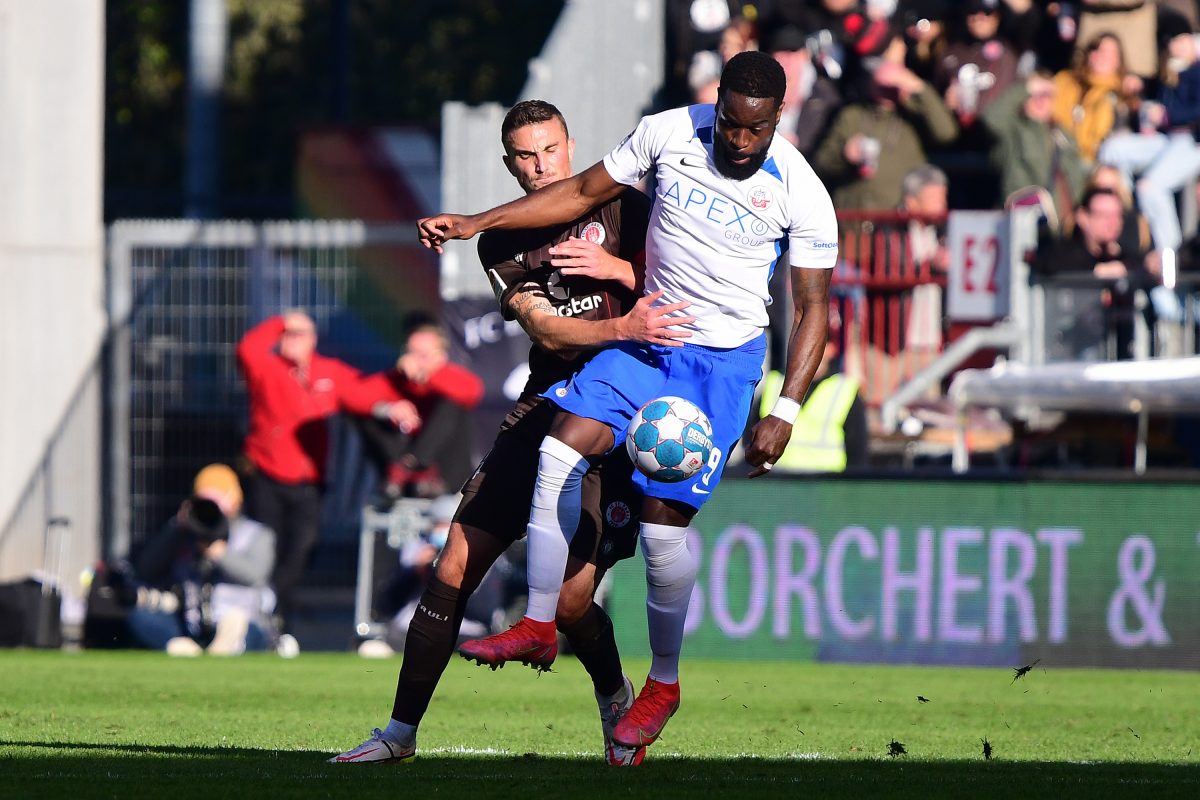
(c) Peter Böhmer
Was jedoch in dieser Saison abläuft, ist schlicht eine unglaubliche Entwicklung. Der FC St. Pauli stellt aktuell mit knapp 66% gewonnener Defensiv-Duelle das zweikampfstärkste Team der gesamten Liga. Letzte Saison war das Team unterer Durchschnitt. Diese Veränderung kann gar nicht hoch genug eingeschätzt werden. Es sind tatsächlich nur rund sechs Prozentpunkte, um die der Wert gestiegen ist. Aber bei mehr als 60 Duellen pro Spiel macht das schon was aus. Zumal noch viel wichtiger ist, wo genau die neue Stärke Anwendung findet, also welche Spieler wie gut ihre Zweikämpfe führen.
Leart Paqarada ist der zweikampfstärkste Außenverteidiger der Liga mit 75% gewonnener Duelle. Zander liegt da auf Platz 7 mit 72%. In der Innenverteidigung liegen Philipp Ziereis (72%) und Jakov Medić (75%) in den Top15. Afeez Aremu liegt mit 73% gewonnener Duelle aktuell auf Platz 2 aller defensiven Mittelfeldspieler (Düsseldorfs Bodzek ist knapp besser). Bester Defensiv-Zweikämpfer auf der Zehnerposition ist, und das verwundert mich schon ein wenig, Daniel-Kofi Kyereh. Im zentralen Mittelfeld liegen Finn Ole Becker auf Platz 10 (63%) und Jackson Irvine auf Platz 12 (61%). Einzig Marcel Hartel fällt da etwas ab (Platz 26 mit 55%), aber der führt dafür das zentrale Mittelfeld bei den abgefangenen Pässen an. Nur ganz vorne im Angriff liegen die Stürmer recht abgeschlagen im unteren Ligaschnitt (was aber auch an der Pressingweise liegen dürfte, da ein verlorenes Duell zwar als verloren in die Statistik eingeht, aber der FCSP damit den Ball genau auf der Seite hat, wo sie ihn haben wollen).
Angesprochen auf diese Entwicklung verweist Timo Schultz ebenfalls darauf, dass es bereits in der vergangenen Rückrunde Verbesserungen in den Zweikämpfen gab. Er hebt dabei besonders, wer hätte es gedacht, Jakov Medić hervor. Aber auch bei Philipp Ziereis betont er, dass dieser sich enorm verbessert habe. Schultz betont auch, dass es nicht nur die individuelle Stärke der Spieler ist, die sich verbessert hat:
„Wir haben uns als Mannschaft verbessert im Defensivverhalten. Diese Zweikampfstatistiken leben auch extrem davon, wie ich als Mannschaft funktioniere. Wie kompakt stehe ich? Wie schnell kann ich in den Zweikämpfen sein? Wie gut ist das Gegenpressing?“
Timo Schultz
Der FC St. Pauli ist in Sachen Zweikämpfe einfach nicht wiederzuerkennen und deutlich das Maß der Dinge in der 2.Liga. Wer hätte das gedacht, nachdem es vor wenigen Monaten noch hieß, dass es dem Team komplett an Physis mangelte? Natürlich ist Jakov Medić ein enorm wichtiger Faktor. Aber Ziereis, Aremu, Paqarada – die waren alle schon da letzte Saison. Und sie haben sich in Sachen Zweikampfführung scheinbar weiterentwickelt. Das finde ich besonders bemerkenswert.
Wo wir gerade bei „Maß der Dinge“ sind. Wir hatten bereits vor einiger Zeit einen Artikel mit dem Titel „Der beste Linksverteidiger der Liga?“ veröffentlicht. Nun können, nein, müssen wir aus dem Fragezeichen ein Ausrufezeichen machen. Leart Paqarada ist schlicht der beste Außenverteidiger der Liga! Schaut mal hier:
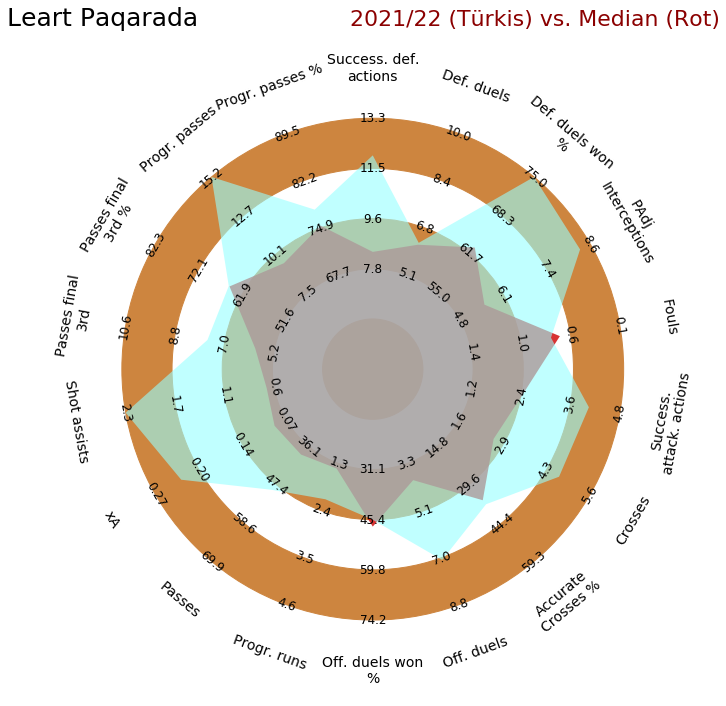
Paqarada hat die beste Zweikampfquote aller Außenverteidiger. Zudem gibt niemand mehr Torschussvorlagen und spielt mehr progressive Pässe (= Pässe, mit denen ein Team dem gegnerischen Tor erheblich näher kommt). Nur Nürnbergs Tim Handwerker schlägt mehr Flanken. Und nur in zwei Kategorien (Anzahl an Fouls und Quote bei den Offensivduellen) ist Paqarada leicht schwächer als der Liga-Durchschnitt. Angesichts der weiteren Statistiken ist das absolut verkraftbar.
Fouls
Wo wir gerade bei Fouls sind: Erst 90x beging der FC St. Pauli während der ersten 11 Spiele ein Foul. Das sind knapp 7.7 Fouls pro Spiel. Der deutlich niedrigste Wert aller Zweitligisten. In der Vorsaison lag der FCSP mit 12.9 Fouls pro Spiel auf Platz 14.
Fouls sind natürlich auf der einen Seite teilweise unvermeidlich, da Zweikämpfe an der Schwelle zum Foul geführt werden. Aber wenn es schon regelwidrig sein muss, dann zumindest in recht ungefährlichen Situationen. Beim Blick in die detaillierte Foul-Statistik fällt auf, dass der FCSP besonders dort, wo der Gegner eine gute Freistoß-Position bekommen würde (in der zentralen Defensive) fast nie foult. Philipp Ziereis foult 0.47x pro Spiel, also jedes zweite Spiel einmal. James Lawrence ist noch fairer mit 0.3 Fouls pro Spiel. Das bedeutet Platz 7 und 5 in der Liga unter den Innenverteidigern. Der fairste Innenverteidiger der Liga? Jakov Medić begeht nur knapp jedes vierte Spiel ein Foul. Im defensiven Mittelfeld liegt Afeez Aremu mit knapp einem Foul pro Spiel auf Platz 6. Das sind überragende Werte für den FC St. Pauli.
Standards
Wo wenig Fouls sind, gibt es wenig Freistöße. Das ist ein Mitgrund, aber nicht alleinig der Grund für eine weitere Stärke, die früher eine große Schwäche war: Der FC St. Pauli hat sich in dieser Saison noch kein einziges Gegentor nach einem Standard gefangen. Das ist mehr als ungewohnt. Blog-Kollege Maik twittert nicht einfach so „Kein Gegentor nach Ecke„, nach jedem Spiel, in dem der FCSP keines gefangen hat. Vielmehr ist es ein Relikt aus vergangenen Tagen, als Gegentore nach Ecken so etwas wie eine Unvermeidlichkeit darstellten.
Das ist es nun schon länger nicht mehr. Die Stärke bei gegnerischen Standards ist auffällig. Entsprechend haben wir Timo Schultz auf der letzten Pressekonferenz danach gefragt. Er hob die individuelle Stärke der Spieler hervor und zeigte sich ebenfalls erfreut, wie stabil sein Team bei Standards ist. Das liege aber nicht nur an der Physis, sondern auch an der Einstellung. Seine Spieler haben die „Wichtigkeit dieser Situationen erkannt“ und sie würden sich entsprechend selbst pushen bei den Defensiv-Standards.
Offensiv zeigt sich ein anderes Bild: Der FC St. Pauli ist zwar keine Tormaschine nach Standard-Situationen, hat aber bereits drei zwei Treffer nach Ecken erzielt (der letzte durch Makienok gegen Rostock). Das finde ich schon fast zu wenig, wenn man sich anschaut, welche großen Chancen der FCSP teilweise v. a. nach Freistoß-Varianten hatte. Aber angesichts von 23 Toren aus dem laufenden Spiel in elf Matches ist das natürlich verkraftbar.
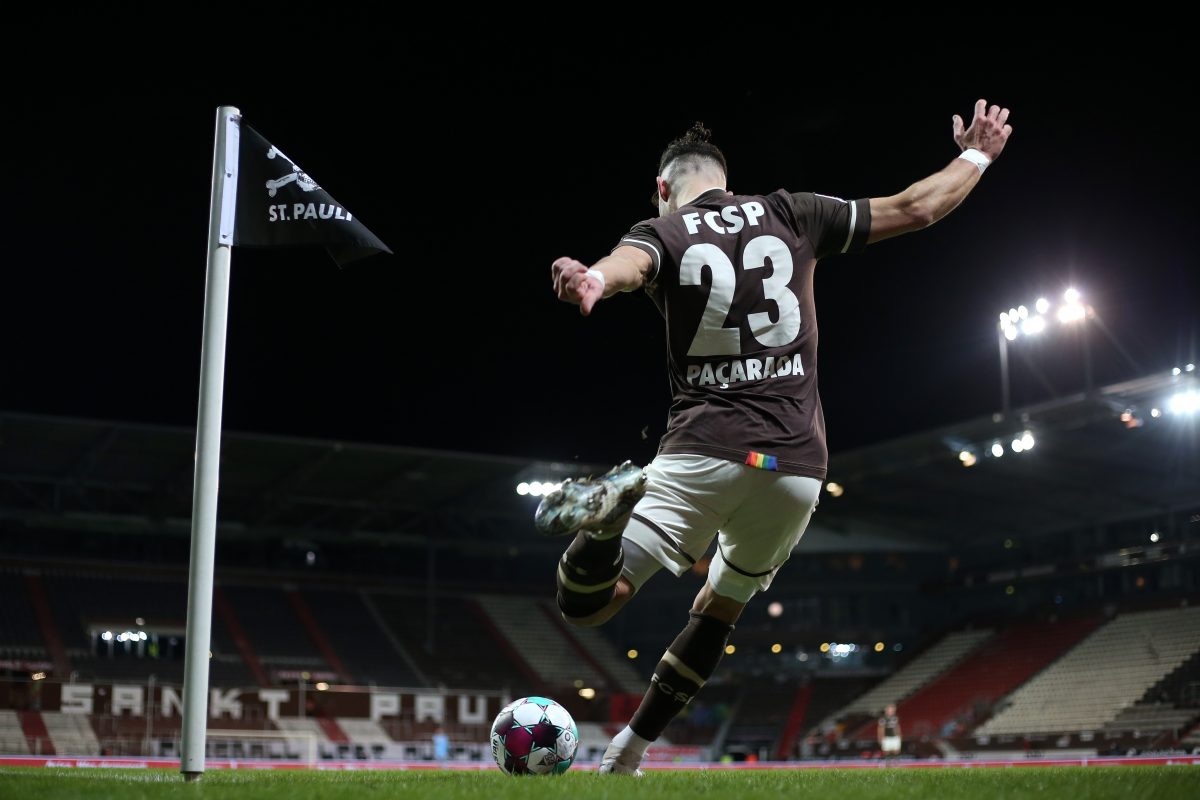
(Cathrin Mueller/Getty Images/via OneFootball)
Offensivfußball
Ja, richtig, 23 Tore aus dem laufenden Spiel. Das ist natürlich ein Bestwert in der Liga, so wie auch die bisher 27 erzielten Tore des FCSP Ligaspitze sind. Der Offensivfußball war bereits in der Vorsaison richtig gut und der FCSP ist immer fähig, vorne Chancen zu kreieren. In dieser Saison sind sie das Team, das sich die meisten Großchancen erspielt und den dritthöchsten xG-Wert der Liga aufweist. Grund hierfür ist der Kombinationsfußball, der uns alle aktuell Woche für Woche begeistert. Kein Team bringt häufiger Pässe im gegnerischen Strafraum zum Mitspieler. In den Kategorien der „wichtigen“ Pässe (Überspielen der gegnerischen Ketten, Torschussvorlagen, Pässe aus dem Druck heraus), liegt der FCSP jeweils in den Top3 der Liga. Bei der Anzahl der Torschüsse ist es aber „nur“ Platz 4, was direkt zum nächsten Punkt überleitet…
Effektivität
156 Torschüsse, also etwas mehr als 13 pro Spiel feuert der FC St. Pauli ab. Die daraus erzielten 27 Tore bedeuten, dass der FCSP weniger als sechs Torschüsse (5.8) für ein Tor benötigt. Nur Darmstadt 98 hat eine bessere „conversion rate“ mit 5.3 Torschüssen pro Tor.
Ein Wert von weniger als sechs Torschüssen pro Tor ist enorm effektiv. In den drei Saisons zuvor lag dieser Wert beim FC St. Pauli immer über acht. Das ist auch in etwa der durchschnittliche Wert aller Teams. Sollte es also sein, dass der FCSP hier überperformed und wir zukünftig weniger Tore erwarten müssen? Womöglich kann die Quote nicht ganz gehalten werden, ja. Aber der xG-Wert spricht eher dafür, dass der FC St. Pauli auch weiterhin weniger als die durchschnittlichen acht Schüsse pro Tor brauchen wird. Denn der FCSP hat den dritthöchsten xG-Wert pro Torschuss und dürfte bei dieser Zahl entsprechend auch weiterhin eine sehr gute „conversion rate“ haben. Außerdem gibt es ja GB9 in unseren Reihen…
Ja, die eigene Offensive ist berauschend und aktuell sehe ich keinen Gegner in der zweiten Liga, der da gegen uns alles wegverteidigen kann. Das war aber auch in der Vorsaison ähnlich, wenngleich nicht ganz so ausgeprägt. Stark verbessert hat sich der FC St. Pauli in Sachen Defensive. Besonders die Zweikampfstärke ist eine krasse Weiterentwicklung. Gleiches gilt auch für die Anzahl an Fouls, welche einhergeht mit wenig Standard-Gegentoren.
Ja, is mir auch klar, das wird bestimmt nicht die gesamte Saison so rosarot weitergehen. Auch wenn es uns momentan schwerfällt, das zu glauben, aber der FCSP wird auch noch Spiele verlieren, vermutlich auch noch ein-zwei Gegentore nach Ecken fangen. (Anm. Maik: Noooooo!) Doch aktuell habe ich das Gefühl, das schon richtig viel auf einmal schieflaufen muss, damit Spiele nicht gewonnen werden.
Die wohl wichtigste Statistik liefere ich ganz am Schluss: Der FC St. Pauli lässt die wenigsten gegnerischen Torschüsse zu. 107 waren es in 11 Spielen, also weniger als zehn pro Spiel. Warum das so wichtig ist? Mit Ausnahme von Ingolstadt in der Saison 17/18 sind in den letzten acht Jahren immer die Klubs aufgestiegen, die am wenigsten gegnerische Torschüsse zugelassen haben. „Offense wins games, Defense wins Championships“ – Beim FC St. Pauli läuft viel richtig momentan.
//Tim
Alle Beiträge beim MillernTon sind gratis. Wir freuen uns aber sehr, wenn Du uns unterstützt.
MillernTon auf BlueSky // Mastodon // Facebook // Instagram // Threads // WhatsApp // YouTube
{:}{:en}25 points after 11 games, top of the league – FC St. Pauli is playing an outstanding season so far. We take a look at the numbers and statistics and try to find out what makes FCSP even stronger than in the previous season. It becomes clear that a lot has changed.
(Cover picture: Peter Böhmer)
As is well known, the second half of the pre-season was already really good. Now, however, FC St. Pauli seems to be even more stable and shows a dominance on the pitch that has not been seen for years. And not in individual games, but week after week. But what adjustments have been made to make things run so smoothly now? What is FC St. Pauli doing better than in the previous season? There are several reasons and answers to these questions.
Duels
It wasn’t so long ago that we presented truly frightening figures here at MillernTon. In January 2021, we asked whether it made sense to sign another centre-back. The answer, based on statistics, was clear: The centre-backs were below average in the „core competencies“ of the defence, such as tackles and headers. FC St. Pauli signed another player at that time, Tore Reginiussen, but Philipp Ziereis and James Lawrence also stabilised in the second half of the season.

(c) Peter Böhmer
What is happening this season, however, is simply an unbelievable development. FC St. Pauli is currently the team with the most tackles in the entire division, winning just under 66% of their defensive duels. Last season, the team was below average. This change cannot be overestimated. It is actually only about six percentage points by which the value has risen. But with more than 60 duels per game, that makes a difference. What is even more important is where exactly the new strength is applied, i.e. which players fight their duels how well.
Leart Paqarada is the most competitive defender in the division with 75% of duels won. Zander is in 7th place with 72%. In central defence, Philipp Ziereis (72%) and Jakov Medić (75%) are in the top 15. Afeez Aremu is currently in second place among all defensive midfielders with 73% of duels won (Düsseldorf’s Bodzek is just better). The best defensive midfielder on the ten-man position is, and this surprises me a little, Daniel-Kofi Kyereh. In central midfield, Finn Ole Becker is 10th (63%) and Jackson Irvine 12th (61%). Only Marcel Hartel falls slightly behind (26th place with 55%), but he leads the central midfield in intercepted passes. Only at the very front of the attack are the strikers quite behind the league average (but this may also be due to the pressing method since a lost duel goes down in the statistics as lost, but FCSP has the ball exactly on the side where they want it).
When asked about this development, Timo Schultz also points out that there were already improvements in the duels during the last second half of the season. He singles out Jakov Medić in particular, who would have thought it? But he also emphasises that Philipp Ziereis has improved enormously. Schultz also emphasises that it is not only the individual strength of the players that has improved:
„We have improved as a team in our defensive behaviour. These tackling statistics are also extremely dependent on how I function as a team. How compact am I? How fast can I be in the duels? How good is the counter-pressing?
Timo Schultz
FC St. Pauli is simply unrecognisable in terms of tackling and is clearly the measure of all things in the 2nd division. Who would have thought that, after it was said just a few months ago that the team was completely lacking in physicality? Of course, Jakov Medić is an enormously important factor. But Ziereis, Aremu, Paqarada – they were all already there last season. And they seem to have developed further in terms of tackling. I find that particularly remarkable.
Speaking of „measure of things“. We had already published an article some time ago with the title „The best left-back in the division?” Now we can, no, must turn the question mark into an exclamation mark. Leart Paqarada is simply the best left-back in the division! Take a look here:

Paqarada has the best tackling rate of all full-backs. In addition, no one gives more assists and plays more progressive passes (= passes that bring a team significantly closer to the opponent’s goal). Only Nuremberg’s Tim Handwerker hits more crosses. And only in two categories (number of fouls and quota in offensive duels) is Paqarada slightly weaker than the division average. In view of the other statistics, this is absolutely tolerable.
Fouls
Speaking of fouls: FC St. Pauli committed only 90 fouls during the first 11 games. That is just under 7.7 fouls per game. The lowest value of all second division teams. In the previous season, FCSP was in 14th place with 12.9 fouls per game.
Of course, fouls are sometimes unavoidable on the one hand, because duels are fought on the threshold of a foul. But if it has to be against the rules, then at least in quite harmless situations. When looking at the detailed foul statistics, it is noticeable that FCSP almost never fouls, especially where the opponent would get a good free kick position (in the central defence). Philipp Ziereis fouls 0.47x per game, i.e. once every second game. James Lawrence is even fairer with 0.3 fouls per game. That means 7th and 5th place in the division among central defenders. The fairest centre-back in the division? Jakov Medić commits a foul just under every fourth game. In the defensive midfield, Afeez Aremu is in 6th place with just under one foul per game. These are outstanding values for FC St. Pauli.
Set-pieces
Where there are few fouls, there are few free kicks. That is one reason, but not the only reason for another strength that used to be a major weakness: FC St. Pauli has not conceded a single goal from a set-piece this season. That is more than unusual. Blog colleague Maik doesn’t just tweet „No goal conceded after corner“ after every game in which FCSP hasn’t caught one. Rather, it is a relic of days gone by, when conceding goals after corners were something of an inevitability.
It hasn’t been for a while now. The strength against opponents‘ set-pieces is striking. Accordingly, we asked Timo Schultz about it at the last press conference. He emphasised the individual strength of the players and was also pleased with how stable his team is when it comes to set-pieces. However, this is not only due to the physicality but also to attitude. His players have „recognised the importance of these situations“ and they push themselves accordingly when it comes to defensive set-pieces.
Offensively, the picture is different: FC St. Pauli is not a goal machine after set-piece situations but has already scored two goals after corners (the last one by Makienok against Rostock). I think that’s almost too few if you look at the great chances FCSP has had, especially from free-kicks. But in view of 23 goals from the current game in eleven matches, that is of course bearable.

(Cathrin Mueller/Getty Images/via OneFootball)
Attacking football
Yes, that’s right, 23 goals were scored directly from situations of the match. That is, of course, the best value in the division, just as FCSP’s 27 goals scored so far are also tops in the league. The offensive football was already really good in pre-season and FCSP are always capable of creating chances upfront. This season, they are the team that creates the biggest chances and have the third-highest xG in the division. The reason for this is their combination football, which currently inspires us all week after week. No team gets more passes to their teammates in the opposing penalty area. In the categories of „important“ passes (overplaying the opponent’s lines, assists on goal, passes out of pressure), FCSP is in the top 3 of the division in each case. In the number of shots on goal, however, it is „only“ 4th place, which leads directly to the next point…
Effectiveness
156 shots on goal, i.e. just over 13 per match, are fired by FC St. Pauli. The 27 goals scored mean that FCSP needs less than six shots on goal (5.8) to score a goal. Only Darmstadt 98 has a better „conversion rate“ with 5.3 shots on goal per goal.
A value of fewer than six shots on goal per goal is enormously effective. In the three seasons before, this value was always above eight for FC St. Pauli. That is also about the average value of all teams. So should it be that FCSP overperforms here and that we should expect fewer goals in the future? It’s possible that the ratio can’t quite be maintained, yes. But the xG value rather suggests that FC St. Pauli will continue to need less than the average eight shots per goal. Because FCSP has the third-highest xG value per shot on goal and should continue to have a very good conversion rate with this number. Besides, there is GB9 in our ranks…
Yes, our own offence is exhilarating and currently, I don’t see any opponent in the second division who can defend everything against us. But that was similar in the previous season, although not quite as pronounced. FC St. Pauli has improved a lot in terms of defence. Especially the strength in tackling is a glaring development. The same applies to the number of fouls, which goes hand in hand with fewer set-piece goals.
Yes, it’s clear to me that things won’t stay this rosy for the whole season. Even if it’s hard for us to believe it at the moment, FCSP will still lose games and probably concede one or two goals from corners. (Note Maik: Noooooo!) But at the moment I have the feeling that a lot has to go wrong at once for games not to be won.
Probably the most important statistic I will provide at the very end: FC St. Pauli allows the fewest opponent shots on goal. 107 in 11 games, i.e. less than ten per game. Why is that so important? With the exception of Ingolstadt in the 17/18 season, the clubs that have been promoted in the last eight years have always been those that have allowed the fewest opponent shots on goal. „Offense wins games, defence wins championships“ – FC St. Pauli has a lot going right at the moment.
//Tim (translation by Arne)
MillernTon Twitter //
MillernTon YouTube //
MillernTon Facebook //MillernTon Instagram //
If you like what we do here, here you’ll find the information on how to support us.
{:}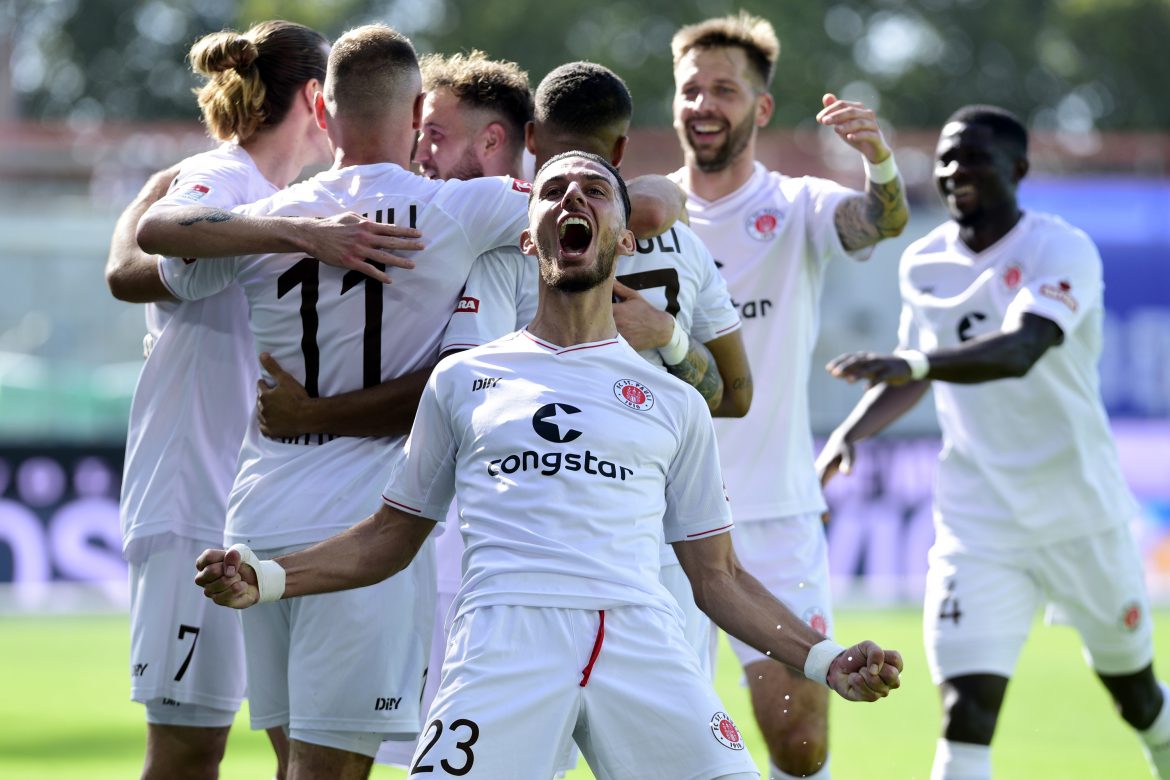

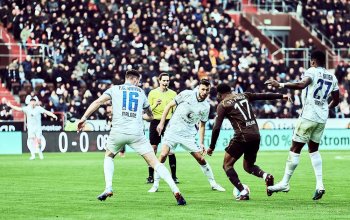

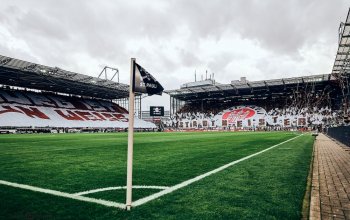
@Maik: Wir brauchen mehr Gegentore nach Ecken! Besonders zu Hause. Oder willst du, dass die Vorstadt am Ende der Saison 2/3 (66,6%!!!!1!) aller Gegentore am Millerntor geschossen hat? #tieffluginZahlen
Da bin ich entspannt. Ich bin mir sicher, dass wir bei bereits feststehendem Aufstieg dann am letzten Spieltag zuhause mit 3 Atü pro Spieler gegen Düsseldorf so richtig verkacken… nicht nur nach Ecke.
Helft mir mal bitte: welches war denn das dritte Tor nach ner Ecke? Zander gg Ingolstadt, Simon gg die Kogge, aber das dritte?
Mmh, da zeigt sich mal wieder, dass man Statistiken nicht so ungeprüft übernehmen sollte. Ich habe die Daten von der DFL übernommen, aber kann mich auch nicht an ein drittes Tor nach einer Ecke erinnern. Wyscout weist auch nur zwei Tore nach Ecken aus. Habe es geändert. Danke für die Nachfrage.
Moin Moin,
ich finde solche Artikel richtig gut!
Anmerkung meinerseits:
von den kommenden 6 Spielen der Hinrunde spielen wir 5 gegen Gegner in den Top 10, d.h. im Umkehrschluss für mich, dass von den bisherigen 11 Gegner vielleicht nicht die ganz starken Teams der Liga dabei waren?!
Ich finde auch, dass unsere Truppe mega guten Fußball spielt, aber in jedem Spiel genug Phasen drin hat, die dafür sorgen sollten, dass die Spieler nicht abheben.
Sehr interessant wird das 2022 wenn es um die Wurst geht, die Truppe weiter gut spielt und gute Ergebnisse einfährt, wie sich die Vertragssituationen auf das ganze Konstrukt auswirken.
Noch 15 Punkte bis zum Nicht-Abstieg und dann voll oben angreifen.
Vielleicht hält man als Verein mit einem Aufstieg dann auch noch ein paar der begehrten Spieler für ein Jahr 1.Buli… Momentan fehlen ja auch noch einige Toppleute
Freue mich auch in Zukunft auf so gute Artikel!
By the way, ich tippe Becker wird im Winter 21/22 schon verkauft…